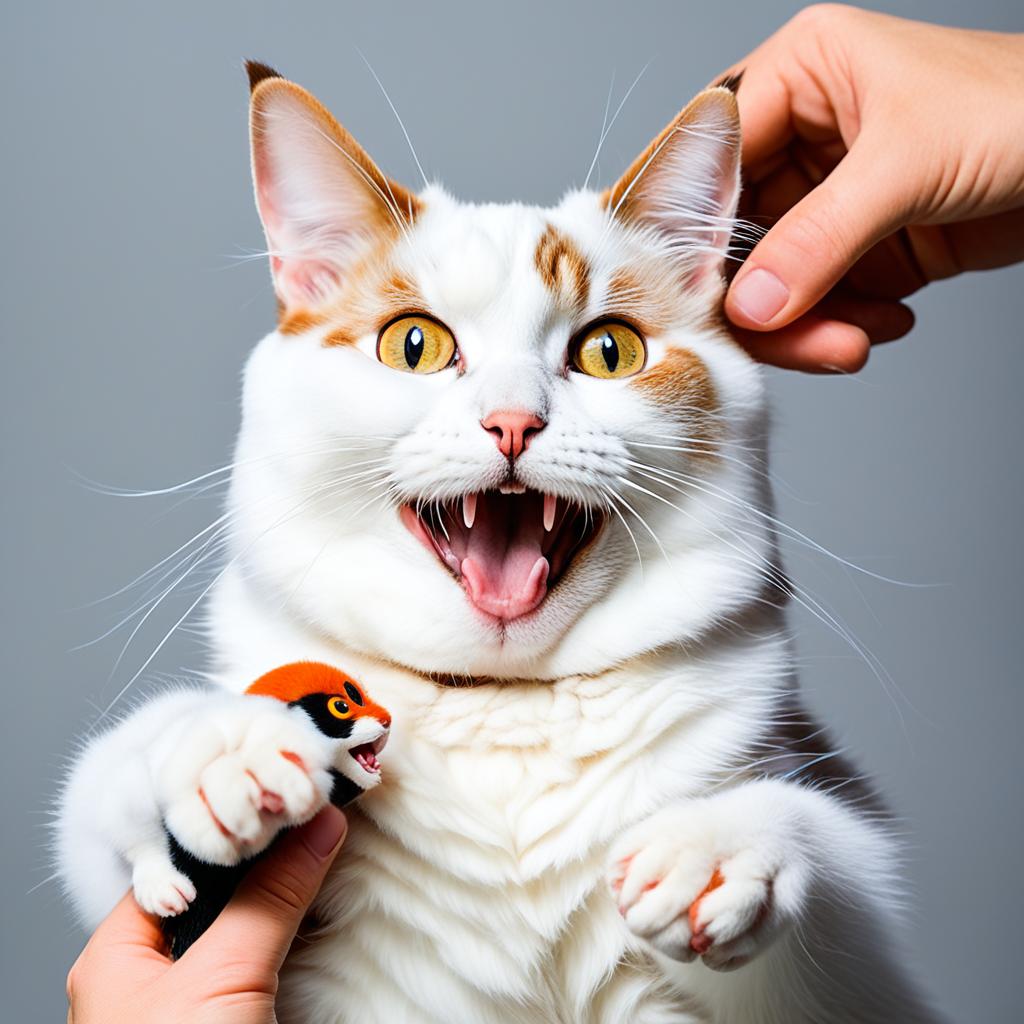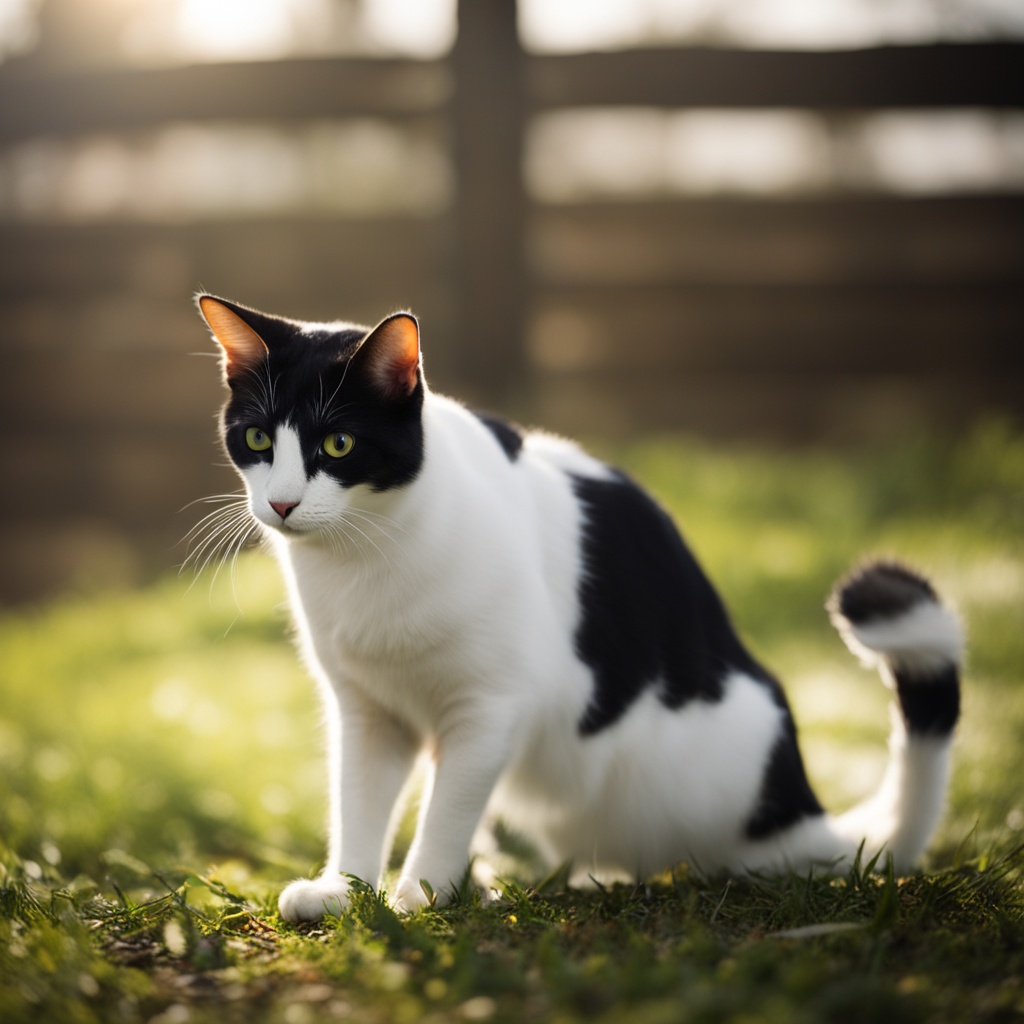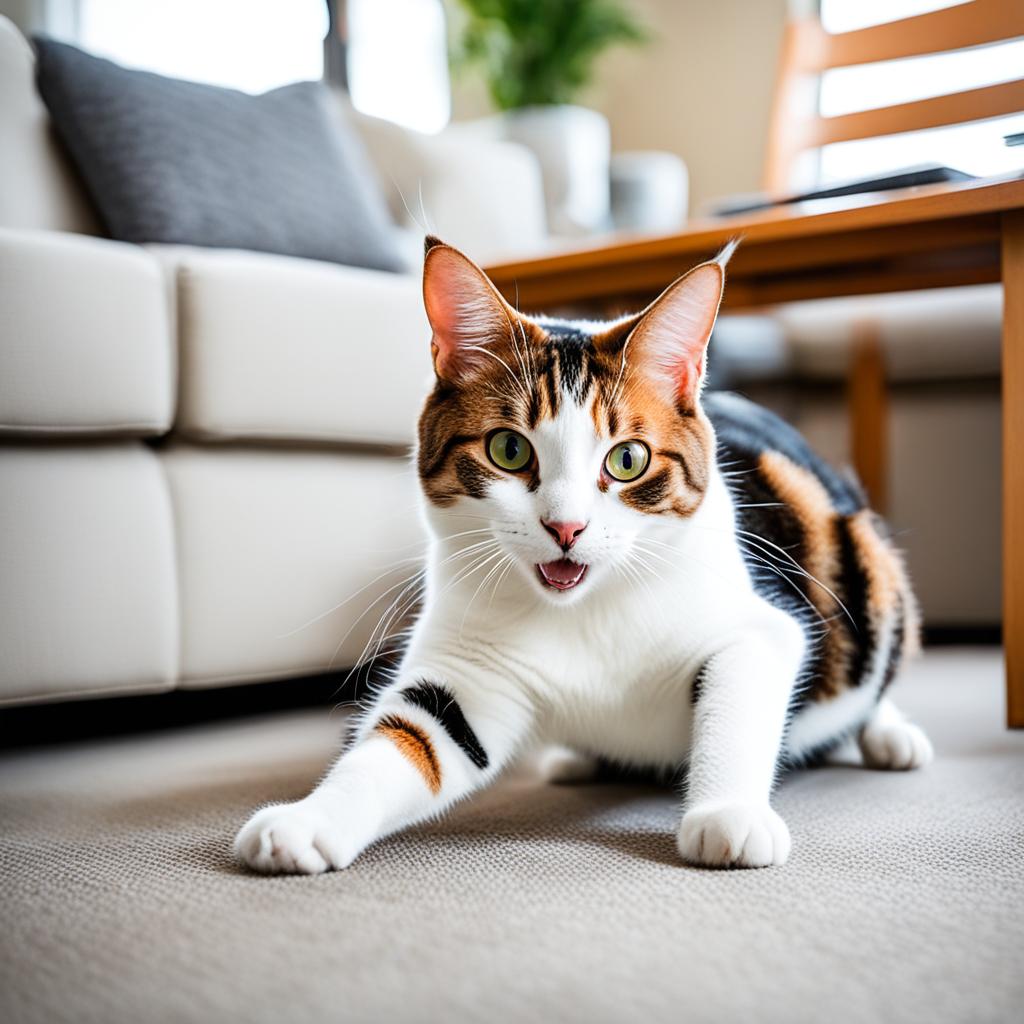Ever wondered why your charming Japanese Bobtail can suddenly turn into a ball of fury? While these delightful felines, affectionately known as “Jibits,” are celebrated for their vivacious personalities, intelligence, and social nature, they can still display aggressive behavior. Understanding how to handle aggression in Japanese Bobtail cats involves addressing their specific needs, from health management to playtime engagement.
These cats, with their impeccable hunting skills and communicative meows, sometimes manifest aggression by overly involving themselves in your activities, displaying mischief when left unattended, or clamoring for constant companionship. Managing their health, including dental care, vaccinations, and routine parasite checks, is crucial. Moreover, spaying or neutering can calm their demeanor, reducing territorial instincts and the overall intensity of their behavior.
Key Takeaways
- Japanese Bobtails, or “Jibits,” are typically friendly but can show aggression.
- Aggressive behavior in cats may stem from boredom or attention-seeking.
- Health management—including vaccinations and dental care—is vital.
- Spaying or neutering can help reduce aggressive tendencies.
- Regular play and mental stimulation are essential to prevent aggression.
Understanding Aggression in Japanese Bobtail Cats

When discussing the fascinating yet sometimes challenging behavior of Japanese Bobtail cats, it’s essential to look at several factors that contribute to their aggression. Addressing and understanding these aspects is crucial for maintaining harmony and health in your furry friend’s life.
Root Causes of Aggression
Aggression in Japanese Bobtail cats may stem from a variety of root causes. Some of the primary aggression root causes include genetic predispositions and environmental influences. While every feline is unique, recognizing the common threads can help you mitigate these issues.
Behavioral Factors
Course correcting the feline behavioral factors, like hunting instincts and the need for interactive play, can significantly improve your cat’s demeanor. These factors are often overlooked but play a critical role in how a Japanese Bobtail expresses its energy and interacts with its surroundings. Regular engagement and understanding their behavioral nuances are essential for a balanced lifestyle.
Health and Medical Issues
Various cat health issues such as obesity, dental disease, and chronic conditions can contribute to or exacerbate aggressive behavior in your Japanese Bobtail. Regular preventive care, tailored to your cat’s specific needs, can go a long way in minimizing these health-related triggers.
Understanding aggression in Japanese Bobtail cats involves a multifaceted approach, but with keen observation and proactive measures, you can create a more harmonious environment for both you and your feline friend.
Types of Aggression in Japanese Bobtail Cats

Understanding the types of aggression in cats, especially Japanese Bobtail cats, can help you manage and reduce aggressive behaviors effectively. These behaviors can be complex and stem from various motivations, demanding specific approaches. Here’s a breakdown of the common types of aggression observed in these cats.
Intermale Aggression
Intermale cat aggression is primarily seen between two intact male cats. This type of aggression is driven by hormonal influences and competition for territory or mates. Neutering can significantly reduce this behavior, making your home a more peaceful place.
Territorial Aggression
Territorial feline aggression is another common behavior, seen when a cat defends its perceived domain from intruders. Signs include hissing, growling, and physical confrontations. Effective strategies may involve environmental management, creating sufficient space, or sometimes rehoming.
Fear-Induced Aggression
Fear-induced aggressive behavior occurs when your Japanese Bobtail feels threatened or startled. Gradual reintroduction to stimuli or environments causing fear can help alleviate this violence. Patience and consistency are key in managing this type of aggression.
Play Aggression
Play aggression in cats can often be mistaken for true aggression. This behavior involves stalking, pouncing, and biting during play. Redirecting your cat to toys and regular play sessions can help mitigate this type of interaction, ensuring it doesn’t turn into harmful behavior towards humans or other pets.
Here’s a quick comparison of these types of aggression and how to manage them:
| Type of Aggression | Main Causes | Management Strategies |
|---|---|---|
| Intermale Cat Aggression | Hormonal, Competition | Neutering, Environmental Enrichment |
| Territorial Feline Aggression | Territory Defense | Environmental Management, Rehoming |
| Fear-Induced Aggressive Behavior | Fear or Threats | Gradual Reintroduction, Patience |
| Play Aggression in Cats | Play Instincts | Redirection to Toys, Regular Play |
Early Signs of Aggression in Japanese Bobtail Cats

Identifying the early signs of cat aggression is crucial for timely intervention and maintaining peace in your home. Japanese Bobtail cats may exhibit subtle changes in their behavior before aggression fully manifests. Recognizing aggressive behavior early can prevent situations from escalating.
- Flattened ears – This can indicate that your cat is uncomfortable or feeling threatened.
- Puffed tail – A sign of heightened agitation or fear, often seen right before an attack.
- Growling or hissing – Audible warnings from your cat signaling discomfort or anger.
Let’s take a closer look at these critical indicators through a comparative lens:
| Indicator | Description | Action |
|---|---|---|
| Flattened ears | Indicative of discomfort or feeling threatened. | Give your cat some space to calm down. |
| Puffed tail | A sign of fear or agitation. | Remove any stress triggers from the environment. |
| Growling or hissing | Vocal signals of anger or unease. | Approach your cat slowly and carefully while speaking softly. |
By proactively recognizing aggressive behavior and monitoring your cat’s environment closely, you can effectively work towards preventing cat aggression altogether. Keep an eye out for these signs and act accordingly to ensure a harmonious multi-cat household.
Methods to Address Aggression in Japanese Bobtail Cats

Managing aggression in Japanese Bobtail Cats requires a multipronged approach, blending behavioral modifications, veterinary interventions, and proper socialization. Here’s how you can ensure a harmonious household with your feline friend.
Behavioral Modification Techniques
Adjusting behavior involves setting clear routines and boundaries to curb undesirable actions. Consistent reinforcement and methods like clicker training can be very effective. Behavioral modification for cats often encompasses positive reinforcement rather than punitive measures. Think of it as guiding rather than disciplining.
Veterinary Solutions
Addressing aggression sometimes calls for veterinary aggression solutions. This might include spaying or neutering to alleviate hormonal-driven behaviors, dietary adjustments for overall well-being, or even prescribed anti-anxiety medications. A vet’s insight is invaluable for tailoring solutions to your cat’s specific needs.
Socialization Practices
Proper socialization from an early age is crucial. Introducing your cat to various environments, people, and other animals gradually can significantly reduce anxiety-driven aggression. Cat socialization techniques include supervised playdates, exposure to new experiences, and creating positive associations with different stimuli. This way, your Japanese Bobtail becomes more adaptable and less prone to aggressive outbursts.
| Method | Description | Benefits |
|---|---|---|
| Behavioral Modification | Using routine and positive reinforcement to set boundaries. | Encourages desired behavior and reduces aggression. |
| Veterinary Solutions | Medical interventions including spaying/neutering and diet changes. | Addresses health-related causes of aggression. |
| Socialization | Gradual exposure to various environments and beings. | Reduces anxiety and improves adaptability. |
Integrating these methods to address cat aggression ensures that your Japanese Bobtail thrives in a peaceful and loving environment.
How to Handle Aggression in Japanese Bobtail Cats?

Handling aggressive Japanese Bobtail cats requires a balanced mix of vigilance and empathy. Start by setting up an environment that wards off potential triggers. Make your home a haven where your cat feels secure and unchallenged. Recognize the cues of aggression and address them proactively. Effective aggressive cat behavior management can involve enriching their surroundings with stimulating toys and activities.
During episodes of aggression, stay calm and composed. Sudden reactions can amplify their anxiety and worsen the situation. Instead, employ an assertive yet soothing approach to calming an aggressive cat. Distraction with their favorite toy or a gentle voice can do wonders. Maintain consistency in your handling methods to build trust and prevent recurrence.
Here’s a closer look:
| Strategy | Purpose | Outcome |
|---|---|---|
| Environmental Enrichment | Reduce boredom and stress | Lowered aggression levels |
| Daily Play Sessions | Redirect energy | Positive interaction and reduced hostility |
| Identify & Avoid Triggers | Minimize encounters with stressors | More relaxed and calmer demeanor |
Implementing these methods consistently can significantly aid in handling aggressive Japanese Bobtail cats. Fostering a bond is key to calming an aggressive cat. A patient and knowledgeable approach to aggressive cat behavior management can transform a tension-filled household into a peaceful coexistence.
Japanese Bobtail Cat Aggression Training Techniques

When it comes to taming the delightful yet sometimes mischievous Japanese Bobtail, adopting effective training techniques is essential.
Using Positive Reinforcement
Sail smoothly through the seas of Japanese Bobtail Cat Aggression Training by embracing Positive Reinforcement Methods. Reward your cat for displaying good behavior using treats, affection, or even an engaging play session. Remember, consistency is key; your furry friend will soon associate good behavior with rewards, paving the way for a happier, less aggressive companion.
Creating a Structured Environment
A Structured Feline Environment offers a sanctuary where your Japanese Bobtail can thrive. Routine and predictability help reduce anxiety-induced aggression. Establishing clearly defined spaces and consistent daily routines ensures they feel secure, which is crucial for mitigating aggressive tendencies. Think of it as decluttering your cat’s life – everything in its place, including their behavior!
Incorporating Play and Enrichment
Engagement through play is a magical tool in your Japanese Bobtail Cat Aggression Training toolkit. Regular Cat Play and Enrichment activities, like interactive toys or puzzle feeders, stimulate their intellect and keep those curious minds occupied. These activities are critical in channeling their energies positively, reducing mischievous behaviors, and fostering a well-rounded, happy cat.
Creating a Stress-Free Environment for Japanese Bobtail Cats

Crafting a stress-free environment for cats is essential to maintaining a calm and happy Japanese Bobtail. To achieve this, you must establish a quiet, stable home atmosphere with plenty of hiding spaces and sanctuaries. Such an environment helps in reducing cat stress and facilitating a more peaceful coexistence for your feline friend.
Avoid sudden changes in your home since these can easily provoke anxiety in your furry companion. Ensuring consistency in the placement of vital resources like food, water, litter boxes, and resting areas is crucial. Consistency provides a sense of security, which is pivotal in minimizing stress in felines.
Incorporating products like Feliway or other feline pheromone diffusers can also be a game-changer. These products release calming scents, effectively promoting a serene atmosphere that keeps your Japanese Bobtail content.
- Maintain a quiet and stable environment.
- Provide ample hiding spaces and sanctuaries.
- Ensure consistency in the location of essential resources.
- Use pheromone products to promote calmness.
Being proactive in this approach not only ensures a better quality of life for your cat but also strengthens the bond you share. After all, a serene and content feline friend is a joy to have around.
Japanese Bobtail Cats: Addressing Common Behavior Problems

Japanese Bobtail cats, with their lively nature and penchant for adventure, sometimes exhibit behaviors that can be challenging. Managing these common behavior problems effectively requires understanding their unique traits and providing suitable solutions.
Mischievous Behaviors
One moment, your Bobtail is seemingly straight out of a Disney movie, and the next, it’s reenacting scenes from a cat version of Mission Impossible. These felines are notorious for their curiosity and playfulness. Addressing cat misbehavior such as this involves keeping them entertained. Interactive toys, puzzle feeders, and cat trees can provide the mental stimulation and physical activity they crave.
To handle these mischievous behaviors, avoid negative reinforcement; instead, redirect their energy towards acceptable activities. Remember, a bored Bobtail is a mischievous Bobtail.
Handling Curiosity-Driven Aggression
Curiosity might be the driving force behind your Bobtail’s playful antics, but it can also lead to aggressive behavior. Managing curiosity-driven aggression is key to maintaining a peaceful home. Redirect their attention using toys designed for active play such as laser pointers or feather wands. This redirection not only alleviates their curiosity but also satisfies their hunting instincts.
Furthermore, creating a stimulating environment with various enrichment activities can keep your bobtail engaged and lessen the chances of aggressive outbursts. Engaging them effectively in play can transform potential aggression into joyful exploration.
Consulting a Veterinarian or Behaviorist
So, your Japanese Bobtail cat has turned from a cute ball of fluff to an unanticipated whirlwind of aggression. You’ve tried everything, but nothing seems to work. When you’ve exhausted all DIY solutions, it might be high time to bring in the pros. Consulting a veterinarian or a cat behaviorist can be the game-changer when dealing with persistent aggression in your feline friend.
Veterinarians are your first lifeline in this scenario. They bring an insightful perspective on Japanese Bobtail cat behavior problems, often rooting out medical issues that could be fueling aggression. A thorough health check can reveal hidden ailments – like dental issues or thyroid problems – that may be prompting your cat’s hostile tendencies. Once medical explanations are ruled out or treated, you’re one step closer to peace at home.
For deeper, more nuanced understanding and longer-term aggression solutions, a cat behaviorist is your go-to expert. With specialized training in feline behavior, behaviorists tailor their approach based on the unique quirks and needs of your Japanese Bobtail. They craft behavior modification plans that align perfectly with your pet’s environment and lifestyle, making the aggression management more effective and sustainable.
Addressing Japanese Bobtail cat behavior problems can be challenging, but bringing in professional help simplifies the journey. Investing in veterinary care and behavioral consultations is a surefire way to transform your feline nemesis back into the charming companion you fell in love with. After all, when it comes to your cat’s behavior, sometimes you need the experts to step in and save the day.




